Walkingsticks are unusual and striking insects that mimic sticks and twigs to camouflage themselves from predators. The longest insect found in the U.S. is found in Texas. The giant walkingstick, Megaphasma dentricus, which can reach seven inches long.
Lifecycle
All walkingsticks go through gradual metamorphosis which means the immature stages look like full grown adults except they are smaller in size. The immature and adult stages feed on leaves.
Adults mate in trees and it is common to see a male and female together. The females randomly scatter round, seed-like eggs by dropping them to the ground. The eggs lie on the ground through the winter and hatch in spring or early summer. Some eggs may not hatch until the second spring. Adults are present during the summer. There is only one generation per year.

Impacts
Though common throughout Texas, giant walkingsticks populations are not usually found in dense concentrations. Occasionally, populations will reach epidemic proportions. This has happened a couple of times in Texas and can result in mass defoliation of hardwood trees. This is not particularly damaging to the trees unless it occurs several years in succession. If it does, the trees may be weakened enough to die. No control is needed for walkingsticks.
Much folklore is associated with walkingsticks, especially large ones. They are sometimes called a devil’s horse, and some people falsely believe they can spit blood in your eyes. Also, many believe that walkingsticks can sting, but this is not true, either. Males have claspers at the end of their abdomen that look dangerous, but they’re not.
The insects may appear intimidating and when picked up their feet can cling very tightly to skin and clothing, but they are completely harmless. Walkingsticks are docile, slow moving, herbivores that are mainly concerned with looking like a stick (excellent camouflage), eating leaves, and mating.
If you happen to find some giant walkingsticks, take the time to observe them and see one of the many wonders of nature.